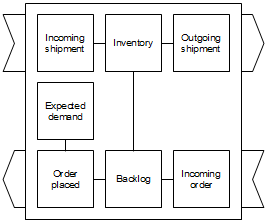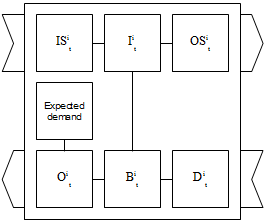1501-ISSL
Box. Business Simulation Laboratory, http://lab.hkilter.com/
Conceptual Framework
Goals
- Creating a robust simulation environment.
- Simulating business processes.
- Analyzing outputs.
- Thinking about the model.
- Sharing knowledge.
Elements
Agents
An individual who is able to do some basic actions. Eg. Worker, Customer, Manager
| Types | Basic actions |
|---|---|
|
|
Units
A small team or unit. Eg. Marketing team, Engineering unit
| Types | Basic actions |
|---|---|
|
|
Small-scale systems
A small system which consists of sub-systems such as small-scale systems, small-scale subsystems, units or individuals. Eg. Company, Entrepreneurship
| Types | Basic actions |
|---|---|
|
|
Medium-scale systems, Type A
300 MEDIUM-SCALE SYSTEM TYPE A (Industry)
Medium-scale systems, Type B
400 MEDIUM-SCALE SYSTEM TYPE B (Market)
Large-scale system
500 LARGE-SCALE SYSTEM (Economy)
Brief information about the System
A system is a set of interacting or interdependent components forming an integrated whole. Every system is delineated by its spatial and temporal boundaries, surrounded and influenced by its environment, described by its structure and purpose and expressed in its functioning.
Some systems share common characteristics, including:
- A system has structure, it contains parts (or components) that are directly or indirectly related to each other;
- A system has behavior, it exhibits processes that fulfill its function or purpose;
- A system has interconnectivity: the parts and processes are connected by structural and/or behavioral relationships;
- A system's structure and behavior may be decomposed via subsystems and sub-processes to elementary parts and process steps;
- A system has behavior that, in relativity to its surroundings, may be categorized as both fast and strong.
Work packages
- TH Theoretical work
- NU Numerical modeling
- CO Coding
- GA Gathering data
- AN Analysis
- RE Reporting
Example Work Package Code: TH001A2
- Type of the work package (TH, NU, CO, GA, AN, RE)
- Level of the work package (100, 200, 300, 400)
- Part of the project schedule (A, B, C)
- Phase of the part (1, 2, 3, 4)
Project Schedule
A. CREATION (12 months)
- Phase 1 (3 months): Creating an agent.
- Work packages: TH000A1 NU000A1 CO000A1
- Phase 2 (3 months): Creating a team which consists of multiple agents.
- Work packages: TH000A2 NU000A2 CO000A2
- Phase 3 (3 months): Creating a unit which includes several teams.
- Work packages: TH100A3 NU100A3 CO100A3
- Phase 4 (3 months): Creating a company which covers traditional units (or functions).
- Work packages: TH200A4 NU200A4 CO200A4 RE200A4
Resource:
B. INITIATION (12 months)
|
B1. STARTING THE ENGINE (3 months)
Resource: |
B2. INTEGRATION (9 months)
Resource: |
C. EXTENSION (12 months)
- Phase 1: Creating the market
- Phase 2: Start the market engine
- Phase 3: Gathering output of the market
- Phase 4: Analysis output
Appendix
|
Figure 1a. Conceptual example of a basic business system. |
Figure 1b. Parametric example of a basic business system. |
|
Figure 2. Flowchart of business processes. |
Figure 3. Conceptual example of a basic business system (moderate complexity). |
|
Figure 4. Combined modules. Representation of a conceptual example of a particular supply chain. | |
References




